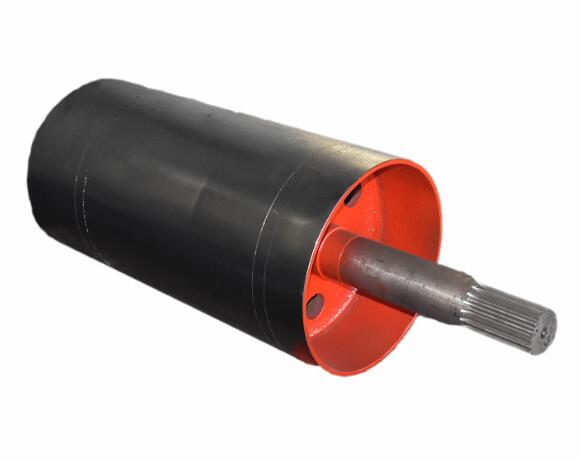transmission drum
Type: Drive drum for belt conveyor
Diameter: 500-1000mm
Length: 500-1400mm
Weight: 200-3500kg
Applicable Machinery: Belt Conveyor
Applicable bandwidth: matches the corresponding length
Introduction: The transmission drum is a component of a conveyor that transmits power. The surface of the transmission drum has exposed smooth steel surface, with herringbone and diamond patterned rubber coating. Bare bare steel surface can be used for low power, low bandwidth, and dry environments. The herringbone pattern adhesive surface has a high friction coefficient, anti slip properties
product details
The drive drum is a component of a conveyor that transmits power. The surface of the transmission drum has exposed smooth steel surface, with herringbone and diamond patterned rubber coating. Bare bare steel surface can be used for low power, low bandwidth, and dry environments. The herringbone pattern adhesive surface has a high friction coefficient, good anti slip and drainage properties, but has directionality. Diamond shaped adhesive surface is used for conveyors that operate in both directions.
TECHNICAL INDEX
Selection of minimum drive drum diameter D:
D=c*d,mm
In the formula, d represents the thickness of the core layer or the diameter of the steel rope, in millimeters
C – coefficient, 80 for cotton fabric, 90 for nylon, 108 for polyester, and 145 for steel cord core.
structure
The transmission drum is composed of a shaft, bearing seat, spoke plate, and cylinder body. The surface is covered with rubber to increase the friction coefficient between the drive drum and the conveyor belt. The bearing seat is equipped with self-aligning roller bearings to ensure the stability of the support and the flexibility of rotation.

Working principle
When the driving device is in operation, the torque in the driving device is transmitted to the drive drum shaft, which is then connected to the drum body through an internal expansion sleeve (or key). Due to the friction between the drum and the belt, the torque is finally transmitted to the belt to drive the operation of the entire leather belt conveyor.
Selection elements
- Length selection
Goods of different widths should be selected with suitable width changing rollers, generally using “conveying material+50mm”.
- Wall thickness and shaft diameter selection
Allocate the weight of the conveyed material evenly to the changing drum in contact, calculate the required load-bearing capacity for each drum, and determine the wall thickness and shaft diameter of the drum.
- Materials and surface treatment
Determine the material and surface treatment (galvanized carbon steel, stainless steel, blackened or coated) to be used for the reversing drum based on the different conveying environments.
- Choose the installation method of the drum
According to the specific requirements of the overall conveyor, choose the installation method: spring press in type, internal tooth shaft type, full flat tenon type, through shaft pin hole type, etc
Maintenance method for transmission drum
- Regularly clean the dust and other foreign objects on the transmission drum.
- Regular inspections should be conducted to ensure the firmness of the welding between the drum shell and the end cover.
- It is necessary to maintain good lubrication of the transmission drum and reduce the damage caused by friction to the transmission drum.
- To avoid overloading the transmission drum and extend its service life.
 Hebei Hengya Conveyor Equipment Co., Ltd
Hebei Hengya Conveyor Equipment Co., Ltd